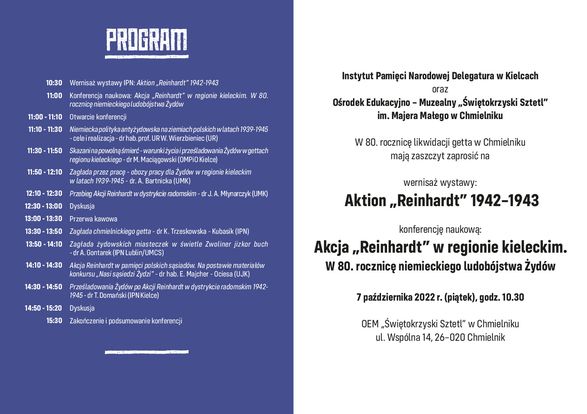During the event, representatives of the IPN’s Sub-Branch in Kielce and "Świętokrzyski Sztetl" will present current initiatives related to the commemoration of the 80th anniversary of Operation Reinhardt in the Świętokrzyskie region. The conference will also be attended by a representative of Polish Radio Kielce, who will provide information on the series of broadcasts entitled "Operation Reinhardt; target: Swietokrzyskie".
Event Schedule
7 October, 2022
10:00 a.m. Press conference
10:30 a.m. Opening of the “Aktion Reinhardt 1942-1943” exhibition
11:00 a.m. Scientific conference: Aktion Reinhardt in the Kielce region. The 80th anniversary of the German genocide of Jews
11:00 a.m. — 11:10 a.m. Opening of the conference
11:10 a.m. — 11:30 a.m. German anti-Jewish policy on Polish lands in 1939—1945, objectives and implementation - Prof. Wacław Wierzbieniec (Rzeszów University)
11:30 a.m. — 11:50 a.m. Condemned to a slow death — living conditions and persecution of Jews in the ghettos of the Kielce region - M. Maciągowski, Ph.D.(OMPiO Kielce)
11:50 a.m. —12:10 p.m. Extermination through labor — labor camps for Jews in the Kielce region in 1939—1945 - A. Bartnicka, Ph.D., (Nicolaus Copernicus University in Toruń)
12:10 p.m. — 12.30 p.m. Operation Reinhardt in the Radom District — J. A. Młynarczyk, Ph.D. (Nicolaus Copernicus University in Toruń)
12:30 p.m. — 1:00 p.m. Discussion
1:00 p.m. — 1:30 p.m. Coffee break
1:30 p.m. — 1:50 p.m. The extermination of the inhabitants of the Chmielnik ghetto — K. Trzeskowska – Kubasik Ph.D, (Institute of National Remembrance)
1:50 p.m. — 2:10 p.m. The extermination of Jewish towns in the light of “Zṿoliner yizker bukh” — A. Gontarek, Ph.D., (Institute of National Remembrance / Maria Curie-Skłodowska University in Lublin)
2:10 p.m. — 2:30 p.m. Operation Reinhardt as engraved in memory of Polish neighbors. Based on materials of the "Our Jewish neighbors" competition — E. Majcher– Ociesa, Ph.D., D.Sc. (Jan Kochanowski University in Kielce)
2:30 p.m. — 2:50 p.m. Persecution of Jews after Operation Reinhardt in Kielce region 1942-1945 - T. Domański, Ph.D. (IPN Kielce)
2:50 p.m. — 3:20 p.m. Discussion
3:30 p.m. Summary
The event is held under the honorary patronage of the Polish Minister of Foreign Affairs, Zbigniew Rau and the Ambassador of Israel to Poland, Yacov Livne
Media patronage: TVP 3 Kielce, Telewizja Swietokrzyska, Lokalna TV, Radio Kielce, Radio eM Kielce, Echo Dnia, Kurier Chmielnicki
Operation Reinhardt
In 1942, the German occupation authorities began a planned genocide of the Jewish population in the occupied Polish territories of the so-called General Government and in Bezirk Bialystok. The operation was given the code name "Reinhardt." As a result, from March 1942 to November 1943, about 2 million Jews were killed.
On 4 August 1942, in the Radom district, part of the Kielce region, "Aktion Reinhardt" started by the liquidation of the small ghetto in Glinice, Radom. The Kielce ghetto was liquidated on 20—24 August. In the largest ghetto in the area, in Czestochowa, the liquidation took place from 22 September to 7 October 1942. Each of these processes was carried out with extreme brutality and violence. The sick, crippled, elderly and pregnant women were murdered on the spot. Others were transferred to the nearest train station, from where the cattle cars took them to the German extermination camp in Treblinka. As some Jews attempted to avoid deportation to extermination camps, a German decree was issued on 10 November 1942, in order to create the so-called secondary ghettos, where several thousand Jews were gathered. In January 1943, they were murdered in extermination camps. After the "liquidation" period of the summer and fall of 1942, the Holocaust entered its further phase. During this time, the Germans liquidated the remains of the ghettos, naming the towns "Judenfrei" (free of Jews), and condemning Jewish refugees to immediate extermination as part of the "Judenjagd" (the hunt for Jews).
The genocide carried out by the German state in the Radom district accounts for 360,000 Jews sent to death as part of "Aktion Reinhardt." Many thousands were killed during the mass shootings that accompanied all liquidation operations.


